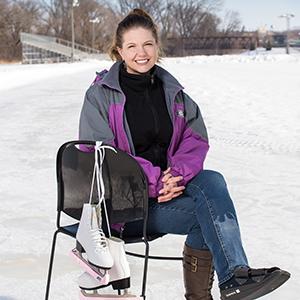Rebecca Gummow

Rebecca Gummow skated through ankle surgery.
Rebecca didn’t grow up skating. So when she lost her balance on the ice, Rebecca fell with her legs crossed “in an awkward curtsy” and landed on her ankle . . . hard. “I could feel the snap and the pop” of bones breaking, she says. “I took my skate off right away because the swelling was instantaneous and intense.”
In the Emergency Department at Northfield Hospital, Dr. Jennifer Block reviewed x rays and consulted with orthopedic surgeon Hans Bengtson, MD to diagnose a trimalleolar ankle fracture: the breaking of the ankle bones in 3 key places. It’s a painful break that requires surgery to realign and stabilize the fractures.
Dr. Block and the ED team set Rebecca’s ankle and splinted it. Dr. Bengtson made plans for surgery once the swelling was down. “Dr. Bengtson was so chill about everything,” Rebecca says. “He’s like, ‘We do this all the time.’ It was really reassuring.”
A trimalleolar fracture might be common, but can be complicated. Dr. Bengtson repaired the fracture using two screws and a small rod to stabilize two of the three main breaks. In Rebecca's case, that stabilized the joint and allowed the third fracture to heal spontaneously.
“I woke up from surgery and my leg didn’t hurt at all,” Rebecca recalls. “I was so overjoyed because it had been in some form of pain for a week. I was just so happy it didn’t hurt. The nurses in the surgery department were really kind. They were patient with me coming out of anesthesia and I felt really well cared-for and safe.”
Rebecca was completely back on her feet (er, foot) in 12 weeks. As a personal trainer with strong physical conditioning, she was able to start physical therapy two weeks after surgery, and was bearing weight on her ankle 8 weeks after her fall (6 weeks after surgery). Therapist Nathan Prissel, DPT led Rebecca through range of motion exercises and gentle stretching, with scar tissue massage to reduce adhesions. As Rebecca’s ankle healed, Nathan gradually added resistance and balance exercises.
The whole experience “was really, really good – the Emergency Room, the surgery, the physical therapy. The staff was so compassionate,” Rebecca says.
Dr. Bengtson “was really positive and reassuring . . . and also very humble,” Rebecca says. “I tried to give him a compliment on the results of surgery, and he turned the compliment back to me.”
From the Emergency Department through surgery and recovery, “I wanted to avoid opioids,” Rebecca says. “They gave me options, let me make my decision, and respected it.”
Her care team used a short-term pain medication to set her bones in the ED, and then a nerve block for surgery that lasted a few days while swelling went down, alleviating any painful pressure inside her cast.
Rebecca’s advice for amateur athletes? “Learn how to fall properly,” she laughs. Then says seriously: “Trust the team. They know what they’re doing. And don’t be afraid to ask questions. Everyone I spoke with was more than willing to take extra time to answer any questions I have. It was a great show of respect to me as a patient.”
